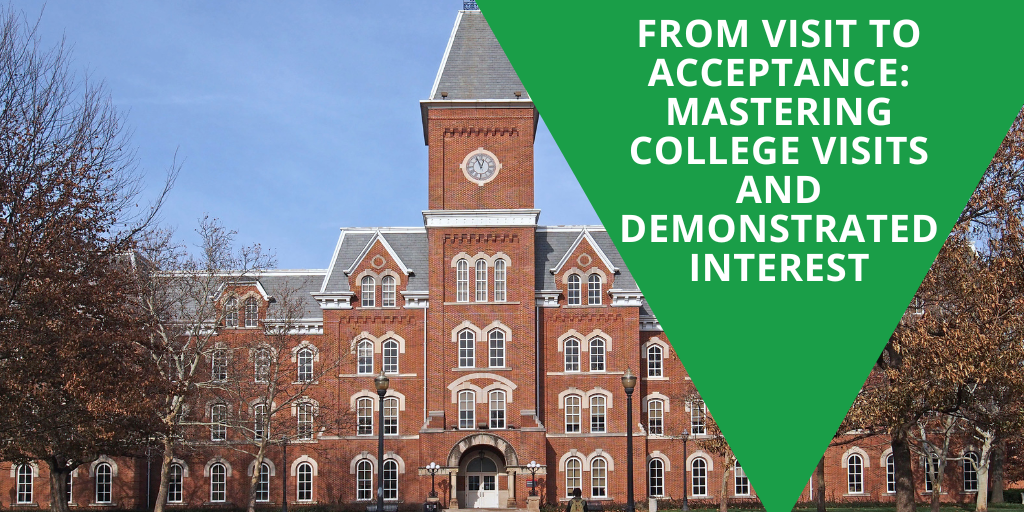From Visit to Acceptance: Mastering College Visits and Demonstrated Interest

As the college admissions process becomes increasingly nuanced and competitive, families are seeking meaningful ways to not only evaluate potential schools but also stand out in the eyes of admissions officers. One of the most valuable—and often underestimated—components of a successful college admissions journey is understanding the importance of college visits and demonstrated interest.
These two elements, when used intentionally, can help students find the right college fit and increase their likelihood of acceptance. Whether it’s stepping foot on campus, attending a virtual session, or writing a well-informed “Why Us?” essay, every action a student takes can signal their genuine enthusiasm for a particular school.
Let’s explore how to make college visits purposeful, what demonstrated interest really means, and how these tools can support both informed decision-making and strategic college applications.
What Is Demonstrated Interest?
Demonstrated interest refers to the actions a student takes to show a college that they are genuinely interested in attending. With thousands of students applying each year, many colleges look for signals that an applicant is not only academically qualified but also eager to enroll if accepted. In a world of increasing application numbers—thanks to the Common App and test-optional policies—demonstrated interest helps schools predict their yield, or the percentage of admitted students who actually enroll.
Demonstrated interest can take many forms, including:
- Campus visits (and signing in at the admissions office)
- Virtual info sessions and events
- College fair attendance and conversations with reps
- Emails to admissions counselors
- Following the college on social media
- Scheduling interviews (if offered)
- Writing specific, compelling “Why Us?” essays
- Applying Early Decision or Early Action
Not all colleges track demonstrated interest, but many do—especially smaller private schools and liberal arts colleges. It's wise to research a college's policy or simply ask an admissions rep if demonstrated interest is considered.
The Power of the College Visit
While brochures and websites can offer plenty of information, there’s no substitute for the experience of physically being on a college campus. Walking the quad, sitting in on a class, or chatting with students in the dining hall can offer insights that no virtual tour can replicate.
But even more than that, college visits allow students to clarify their priorities and get a feel for a school’s personality. Is the environment collaborative or competitive? Do students seem engaged? Are resources like career services, mental health support, and internship opportunities accessible?
Benefits of Visiting Campus:
✅ Clarify Fit: Students can better understand what they want—and don’t want—in a college.
✅ Build Confidence: Familiarity with campus can reduce anxiety during the application and decision-making process.
✅ Show Interest: Many schools track visits and record that data in the student’s file.
✅ Gather Specific Details: These can be used later in essays and interviews to demonstrate thoughtful engagement.
How to Get the Most Out of a College Visit
A college visit is more than just a walk around campus—it's an opportunity to engage, explore, and evaluate. Here are key strategies to make the most of the experience:
1. Schedule Strategically
Visit while school is in session if possible. This allows students to observe the campus energy, class participation, and extracurricular life.
2. Attend the Info Session and Tour
These are often led by admissions staff and current students. They provide an overview of academic offerings, student life, and application expectations.
3. Take Notes
Encourage students to jot down their impressions—both positive and negative. These details will be useful when it’s time to reflect on their choices or write application essays.
4. Explore Independently
After the formal tour, walk through academic buildings, residence halls, and surrounding neighborhoods. Grab a coffee in the student union or sit in on a class (if allowed).
5. Ask Questions
Engage authentically with students and staff. Questions like “What surprised you about attending here?” or “How supportive are professors outside of class?” can yield deeper insight.
6. Follow Up
If a student connects with an admissions rep or professor, a brief thank-you email is a simple but powerful way to reinforce interest and professionalism.
Virtual Visits Still Count
Not every student can travel to every campus—and colleges know this. In recent years, virtual programming has expanded dramatically. Admissions offices now offer:
- Live virtual tours
- Department-specific sessions (e.g., engineering or arts)
- Student panels
- One-on-one chats with admissions reps
- Webinars on financial aid, diversity initiatives, and student life
Students should register for and attend these events using their legal name and the same email used in their application. This ensures their engagement is tracked properly.
Incorporating Demonstrated Interest Into the Application Process
Demonstrated interest is not a one-time gesture—it’s about building a relationship with the school over time. Here's how students can integrate that engagement into their application:
✍️ “Why Us?” Essays
These essays are a prime opportunity to highlight specific programs, values, or experiences that connect the student with the college. Mentioning a favorite class visit, a conversation with a student ambassador, or a club seen during a tour makes the essay more personal and convincing.
📧 Emailing Admissions
Students can email regional reps with thoughtful questions or updates. This shouldn’t be done excessively, but one or two well-timed messages can make a positive impression.
🗓️ Attending Regional Events
Many colleges host local information sessions or attend high school college fairs. Showing up, asking questions, and signing in helps the student be seen as genuinely interested.
🧭 Applying Early
While not solely about demonstrated interest, applying Early Decision (a binding commitment) or Early Action can indicate to a school that it is a top choice.
A Note on Authenticity
While strategy matters, authenticity is key. Students should never engage with a college simply to appear interested. Visits, emails, and essays should reflect a real connection and curiosity. Admissions officers are skilled at spotting generic or insincere efforts.
At the same time, students should feel empowered to advocate for themselves and to be thoughtful about how they present their interest. The best applications come from students who have explored deeply and are excited about their potential fit at a particular school.
Final Thoughts
College visits and demonstrated interest play a powerful role in helping students find schools where they will thrive—and in helping colleges identify applicants who are truly excited about joining their community.
Whether through in-person visits, virtual sessions, or well-crafted essays, students have multiple ways to explore campuses and make meaningful connections. These efforts, when paired with a strong academic record and a compelling story, can tip the scales in a student’s favor.
By taking these steps intentionally, students aren’t just boosting their chances of getting in—they’re making sure they find a college where they’ll be happy, successful, and supported.




